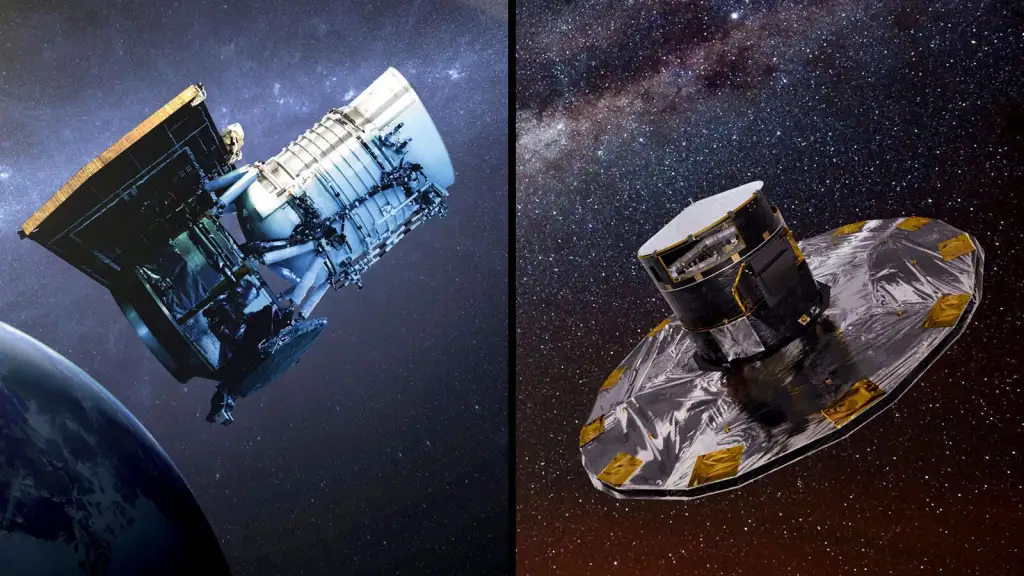Dyson Spheres are a theoretical concept that emerged from both the realms of theoretical physics and science fiction. These massive structures are envisaged to completely encircle a star in order to capture and harness its immense energy output. The idea was popularized by the renowned physicist Freeman Dyson in the 1960s, who speculated that advanced extraterrestrial civilizations might construct such megastructures to meet their escalating energy demands.
Originally introduced in Dyson’s seminal paper “Search for Artificial Stellar Sources of Infrared Radiation,” the concept has since intrigued scientists and enthusiasts alike. Dyson proposed that a civilization significantly more advanced than ours could potentially build a shell or a swarm of satellites around a star to capture its radiant energy, providing a nearly inexhaustible power source. In science fiction, Dyson Spheres have been depicted as colossal and intricate constructs, showcasing the technological prowess of advanced species.
The theoretical underpinnings of Dyson Spheres are rooted in the Kardashev Scale, which categorizes civilizations based on their energy consumption. A Type I civilization utilizes the energy available on its home planet, while a Type II civilization can harness the total energy output of its star. Dyson Spheres represent a quintessential example of a Type II civilization’s capability, reflecting an extraordinary level of technological sophistication.
The allure of Dyson Spheres extends beyond mere speculation. They offer a framework for scientists to hypothesize about the potential methods and materials required for constructing such structures. This concept also provides insight into how humanity might one day achieve similar feats, should our technological advancements continue at an exponential pace.
Moreover, Dyson’s hypothesis has spurred the scientific community to consider these megastructures as potential indicators of alien life. By observing anomalous stellar signals or energy patterns, researchers hope to identify signs of such advanced civilizations. This search for extraterrestrial intelligence (SETI) has thus integrated the concept of Dyson Spheres into its array of investigative tools, making it an enduring topic of both scientific inquiry and imaginative exploration.
The Theory Behind Detecting Dyson Spheres as Signs of Alien Life
The concept of Dyson Spheres as a means to detect alien civilizations is rooted in the hypothesis that advanced extraterrestrial societies would harness and utilize vast amounts of energy. Proposed by physicist Freeman Dyson in 1960, the Dyson Sphere refers to an immense, hypothetical structure that an advanced civilization might build around its star to capture a significant portion of the star’s energy output. The rationale behind this theory is that the energy requirements of an advanced society would eventually surpass what is available on their home planet, necessitating the construction of such a megastructure.
One of the key observables from a Dyson Sphere is the immense energy it would harness, which would produce an identifiable infrared signature. As the star’s light is absorbed and utilized by the Dyson Sphere, the structure would re-radiate energy in the form of infrared radiation. This distinctive infrared signature could potentially be detectable by astronomers on Earth, providing indirect evidence of the existence of an advanced alien civilization.
However, detecting these infrared signatures presents significant technical challenges. The primary obstacle is the vast distances involved, which make the signals extremely faint and difficult to discern from the cosmic background radiation. Additionally, natural astrophysical phenomena, such as dust clouds and other celestial objects, can also emit infrared radiation, complicating the identification of potential Dyson Spheres.
Astronomers employ several methods to search for these infrared signatures, including the use of space telescopes equipped with sensitive infrared detectors. Missions like the Wide-field Infrared Survey Explorer (WISE) and the Infrared Astronomical Satellite (IRAS) have been instrumental in scanning the sky for unusual infrared emissions. Advanced data analysis techniques, including machine learning algorithms, are also utilized to sift through vast amounts of observational data to identify potential anomalies that could indicate the presence of a Dyson Sphere.
Despite the challenges, the search for Dyson Spheres continues to be a fascinating aspect of the quest to detect alien life. By understanding the theoretical underpinnings and employing sophisticated technology, scientists hope to one day identify these elusive signatures and, in doing so, uncover evidence of extraterrestrial civilizations.
Historical Attempts to Find Dyson Spheres
The search for Dyson Spheres, a theoretical megastructure that could encapsulate a star to harness its energy, has fascinated astronomers and scientists for decades. One of the earliest and most notable efforts in this quest was the Infrared Astronomical Satellite (IRAS) mission in 1983. IRAS aimed to scan the entire sky in infrared wavelengths. Since Dyson Spheres would emit significant infrared radiation, this mission was crucial in the initial hunt for such megastructures. Although IRAS did not confirm the existence of any Dyson Spheres, it set the groundwork for future studies by cataloging numerous infrared sources that could be investigated further.
Following IRAS, NASA’s Wide-field Infrared Survey Explorer (WISE), launched in 2009, continued the search with improved technology and greater sensitivity. WISE aimed to create a more detailed map of the sky in infrared light, offering a higher resolution and better detection capability than its predecessors. Researchers utilized WISE data to investigate unusual infrared signatures that might indicate the presence of a Dyson Sphere. Despite the comprehensive nature of these surveys, WISE also did not provide definitive evidence of Dyson Spheres. However, it significantly expanded the database of celestial objects with peculiar infrared emissions, enabling more targeted future investigations.
The findings from these early attempts have been both enlightening and limiting. While no Dyson Spheres have been confirmed, the data gathered has enriched our understanding of the universe and provided a foundation for more sophisticated searches. The primary limitation of these studies has been the vastness of space and the relatively narrow focus on infrared emissions alone. As technology advances, new methodologies and broader spectrum analyses are being employed, raising hopes for more conclusive results in the future. These historical efforts have underscored the complexity of detecting theoretical constructs like Dyson Spheres and have paved the way for ongoing and future research endeavors.
Recent Advances in Technology and Methodology
The search for Dyson Spheres, a theoretical concept proposed by physicist Freeman Dyson, has gained significant momentum due to recent advancements in technology and methodology. One of the most notable improvements has been in the field of infrared detection. Modern telescopes, such as the James Webb Space Telescope (JWST), are equipped with state-of-the-art infrared sensors that can detect the faint heat signatures emitted by potential Dyson Spheres. This capability is crucial, given that a Dyson Sphere would likely emit a significant amount of infrared radiation as it captures and utilizes the energy of its host star.
Alongside advancements in telescopic technology, data analysis methods have also seen substantial improvements. The enormous volume of data generated by contemporary telescopes necessitates sophisticated algorithms for processing and interpretation. Machine learning algorithms, in particular, have revolutionized our ability to sift through this data efficiently. These algorithms can identify patterns and anomalies that might indicate the presence of a Dyson Sphere, significantly reducing the time and effort required for manual analysis.
Moreover, computational methods have evolved to support more complex simulations and models. High-performance computing enables scientists to simulate various scenarios involving Dyson Spheres, providing a theoretical framework that can be compared against observational data. These simulations are invaluable for understanding the potential signatures a Dyson Sphere might produce, guiding researchers in their search.
Improvements in data storage and sharing have also facilitated collaborative efforts across the scientific community. Large datasets can now be stored and accessed more easily, allowing researchers from various institutions to work together in analyzing potential Dyson Sphere candidates. This collaborative approach enhances the robustness of the findings, as multiple experts can cross-verify results and provide different perspectives.
In summary, the combined advancements in infrared detection, data analysis, machine learning, and computational methods have significantly bolstered our ability to search for and potentially identify Dyson Spheres. These technological and methodological improvements are crucial steps forward in the ongoing quest to detect signs of extraterrestrial civilizations.
The New Evidence: What Scientists Have Found
Recent advancements in astronomical research have brought to light intriguing evidence that may point to the existence of Dyson Spheres, an extraordinary concept hypothesized for detecting advanced extraterrestrial civilizations. Scientists have focused their observations on a star known as KIC 8462852, commonly referred to as Tabby’s Star. This star has exhibited unprecedented and irregular dimming patterns, which have sparked a considerable amount of interest and speculation within the scientific community.
Using data from the Kepler Space Telescope, researchers noticed that Tabby’s Star experienced significant dips in brightness, sometimes by as much as 22%. These fluctuations are far more dramatic than what is typically observed in other stars, where brightness variations are generally minor and predictable. To ascertain the cause of these anomalies, scientists employed a variety of data analysis methods, including photometric monitoring and spectral analysis.
Photometric monitoring involves measuring the intensity of light from a star over time, which in the case of Tabby’s Star, revealed erratic dimming events that could not be easily attributed to known astrophysical phenomena such as planetary transits or star spots. Spectral analysis was used to examine the star’s light spectrum for signs of material or objects that might be causing the dimming. The absence of typical markers associated with dust or debris has led some researchers to hypothesize that the dimming could be due to a swarm of megastructures, potentially indicative of a Dyson Sphere or a similar construct.
These findings are significant as they represent the first time a star’s light behavior has suggested the possible existence of an advanced alien megastructure. Unlike previous data, which could usually be explained by natural cosmic events, the observations of Tabby’s Star pose a unique challenge to existing astrophysical theories. While the idea of a Dyson Sphere remains speculative, the data from Tabby’s Star has reignited interest in the search for extraterrestrial intelligence (SETI) and highlights the importance of continued observation and analysis.
Evaluating the Evidence: Potential Natural Explanations
The search for Dyson Spheres, colossal structures that could envelop a star to harness its energy, has captivated scientists and the public alike. However, the intriguing infrared signatures that some researchers attribute to these megastructures might have more mundane explanations. Understanding these natural phenomena is crucial to distinguishing between potential alien artifacts and cosmic mirages.
One plausible natural explanation for the observed infrared anomalies is the presence of interstellar dust clouds. These clouds can absorb the visible light from a star and re-emit it as infrared radiation. Such processes can mimic the expected signature of a Dyson Sphere, leading to potential misinterpretations. Moreover, young stellar objects surrounded by protoplanetary disks exhibit similar infrared excesses as they accrete material and form planetary systems. These disks can obscure the star in visible wavelengths while glowing brightly in the infrared spectrum.
Another compelling candidate is the phenomenon of red giant stars. As these stars age, they expand and shed their outer layers, creating circumstellar envelopes rich in dust and gas. These envelopes can produce significant infrared emissions, closely resembling the hypothesized Dyson Sphere signatures. Additionally, asymptotic giant branch (AGB) stars, which undergo intense mass loss, can also exhibit pronounced infrared excesses due to their dense, dusty shells.
Astrophysical processes such as stellar mergers or collisions can also contribute to the observed infrared emissions. When two stars collide, the resulting debris and shock waves can generate substantial infrared radiation. Similarly, binary star systems where one star is actively accreting material from its companion can produce infrared excesses through the heated accretion disk.
While these natural explanations offer compelling reasons for the observed infrared signatures, the likelihood of each scenario varies. Interstellar dust clouds and young stellar objects are relatively common and can easily account for many of the detected anomalies. Red giant and AGB stars, although less frequent, still present a viable explanation. Stellar mergers and accretion phenomena, while rarer, cannot be entirely ruled out.
In assessing the evidence, it becomes clear that while the Dyson Sphere hypothesis remains an exciting possibility, natural cosmic structures and astrophysical processes provide robust alternative explanations. Comprehensive analysis and further observational data are essential to refine our understanding and draw more definitive conclusions.
Implications for the Search for Extraterrestrial Life
The potential discovery of Dyson Spheres presents a transformative opportunity for the search for extraterrestrial intelligence (SETI). Such a finding would not only validate the existence of advanced extraterrestrial civilizations but also fundamentally reshape our understanding of technological progress and survival in the universe. This theoretical concept, if substantiated, could serve as a beacon, guiding future research directions in astrobiology and SETI.
The implications for research are profound. With evidence suggesting the existence of Dyson Spheres, scientists would prioritize the identification of other similar structures within our galaxy and beyond. This discovery would necessitate the development of more sophisticated observational technologies and methodologies. Enhanced infrared telescopes and other instruments capable of detecting the specific energy signatures of Dyson Spheres would become critical. Consequently, this shift in research focus would likely attract increased funding from both governmental and private sectors, recognizing the significant leap in our quest to understand the cosmos.
Moreover, the search for Dyson Spheres would foster greater international collaboration. The profound nature of such a discovery transcends national boundaries, urging a collective effort to pool resources, share data, and coordinate observational campaigns. International partnerships, such as those facilitated by organizations like the United Nations Office for Outer Space Affairs (UNOOSA), could play a pivotal role in orchestrating a unified global response.
In addition to technological and collaborative advancements, the discovery of Dyson Spheres would have philosophical and ethical ramifications. Humanity would need to grapple with the knowledge that we are not alone in the universe, prompting introspection about our place and responsibilities as a species. This newfound perspective could inspire renewed interest in space exploration, driving humanity to aspire towards greater achievements in science and technology.
Ultimately, the potential discovery of Dyson Spheres signifies a paradigm shift in SETI and astrobiology. It calls for a re-evaluation of our strategies, fostering innovation, collaboration, and a deeper understanding of our universe. As we stand on the cusp of potentially groundbreaking discoveries, the quest to detect extraterrestrial life is poised to enter an exciting new era.
Future Prospects and Research Directions
As the scientific community delves deeper into the theoretical concept of Dyson Spheres and their implications for detecting alien life, several future prospects and research directions emerge. One of the foremost avenues is the development of advanced telescopes and observational technologies. Projects like the James Webb Space Telescope (JWST) and the upcoming Extremely Large Telescope (ELT) promise unprecedented sensitivity and resolution, enabling researchers to detect the subtle signatures of potential Dyson Spheres or similar megastructures around distant stars.
Collaborative efforts among international space agencies and research institutions will be crucial in this endeavor. Joint missions and data-sharing agreements can significantly enhance our collective ability to identify and study these hypothetical constructs. For instance, the Breakthrough Listen initiative, a comprehensive search for extraterrestrial intelligence (SETI), could incorporate specific algorithms designed to detect the energy patterns indicative of a Dyson Sphere.
In addition to observational advancements, theoretical research continues to play a vital role. Scientists are refining models that predict the energy output and waste heat signatures of Dyson Spheres. These models are essential for distinguishing genuine signals from natural astrophysical phenomena. Computational simulations and machine learning techniques are increasingly employed to analyze vast amounts of data from space observatories, streamlining the search for anomalies that could suggest extraterrestrial engineering.
Looking further ahead, proposed missions to explore exoplanets and their surrounding environments could yield additional insights. Missions like the Transiting Exoplanet Survey Satellite (TESS) and the PLAnetary Transits and Oscillations of stars (PLATO) are designed to detect small transiting exoplanets, but they also hold the potential to identify unusual dimming patterns that might be attributed to large-scale artificial structures.
Ultimately, the quest to detect advanced extraterrestrial civilizations through the study of Dyson Spheres remains a multifaceted and evolving field. The integration of cutting-edge technology, international collaboration, and innovative theoretical models will pave the way for groundbreaking discoveries. The pursuit of this knowledge not only enhances our understanding of the universe but also addresses one of humanity’s most profound questions: Are we alone in the cosmos?



































